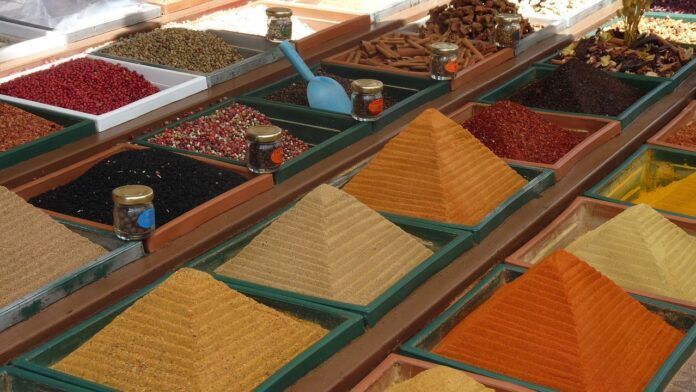In this article, we’ll explore the leading spice producing countries in the world. We’ll skip the in-depth analysis of the spice industry and focus on sharing this information in a more conversational manner.
Spices play a crucial role in enhancing the flavor of our food, whether in their fresh or dried forms. They also serve as natural preservatives, ensuring our meals stay tasty and fresh. Surprisingly, spices are quite the global commodity, ranking as the 618th most traded product worldwide, as reported by The Observatory of Economic Complexity (OEC).
Beyond their culinary uses, spices have found a new home in the cosmetics industry, thanks to their organic and healing properties. Various herbs and spices, such as cinnamon, vanilla, saffron, chili pepper, ginger, coriander, and cardamom, are now being incorporated into perfumes and colognes. For instance, the famous Terre d’Hermès perfume introduced black pepper to create a warm and sensual fragrance. Vanilla, on the other hand, has become a sought-after ingredient in perfumes from brands like Saint Laurent, Dior, and Chanel.
Read More: Benefits of Ginger for Your Body and Health
As of 2021, the global spices and seasoning industry boasted an estimated value of around $18 billion. Projections from Fortune Business Insights indicate that this industry is on track to reach $25.4 billion by 2029, with a steady compound annual growth rate of 4.67%. A significant portion of spice production, over 80%, comes from Asia, predominantly southern Asia. India’s spice market, for instance, is heavily influenced by companies like Everest Food Products Pvt Ltd and Mahashian Di Hatti Private Limited (MDH), which together hold a substantial 30% share of the country’s spice market.
Everest, for example, has made its mark with products available in over 400,000 stores across India. Their website proudly notes that 20 million households in India use their products daily, and they sell more than 3.7 billion packs each year. Their impressive product range includes over 200 items, featuring a staggering 52 different spices that are exported to 80 countries. Meanwhile, in Karachi, Pakistan, Shan Foods is another major player in the spice industry, offering an array of pure and blended spices, as well as cooking pastes, sauces, and dessert mixes. Established in 1981, Shan Foods exports its products to 65 countries on five continents, raking in an impressive $490 million in revenue in 2021.
United States Spice Market
The United States stands as the world’s largest importer of spices, racking up an import bill of $1.99 billion in 2022, marking a 7.16% increase compared to the previous year. The widespread use and demand for spices in the country are compelling spice industry players to embrace new trends to boost their efficiency and meet the growing appetite for these flavors.
Leading the charge is McCormick & Company, Incorporated (NYSE:MKC), the largest spice company globally. They’ve turned to artificial intelligence to concoct novel flavor profiles that tantalize consumers’ taste buds. In 2019, McCormick & Company revealed a collaboration with IBM to develop an AI system. This system digs through four decades of spice-related data, enabling the company to craft fresh spice combinations. McCormick & Company, Incorporated (NYSE:MKC) is renowned for manufacturing and distributing spices, seasoning mixes, and flavor-enhancing products, selling its wares in over 170 countries. In 2022, the company boasted $6.35 billion in sales.
Read Also: How to Use Leftover Coffee Grounds?
On another front, numerous corporations are venturing into the spice industry by establishing dedicated units. One such example is B&G Foods, Inc. (NYSE:BGS), an American food company that made headlines in 2016 when it acquired the Spice Island, Tone’s, and Durkee brands of the spice and seasoning business from ACH Food Companies for a hefty $365 million. B&G Foods, Inc. (NYSE:BGS) sought to tap into the spice industry’s high demand in the United States. At the time of acquisition, they projected annual revenues exceeding $220 million once fully integrated. In 2022, the company announced a restructuring into four units, with the spice segment anticipated to contribute 18% of total net sales.
The Kraft Heinz Company (NASDAQ:KHC) also made waves recently by announcing its plans to introduce Just Spice, Europe’s beloved spice brand, to the United States. This move came a year and a half after The Kraft Heinz Company acquired a majority stake in the business. Just Spices specializes in selling mixed spice blends through online and retail channels. In 2021, The Kraft Heinz Company acquired an 85% shareholding in the Germany-based startup, boasting a product portfolio of 170 items and generating €60 million in sales. Rafael Oliveira, the international zone president of The Kraft Heinz Company (NASDAQ:KHC), described this deal as an opportunity to accelerate company growth and stay ahead of consumer preferences.
Even kitchenware providers are seizing the business potential offered by the spice industry. Take Lifetime Brands, Inc. (NASDAQ:LCUT), for example, which offers a tempting Free Spice Refill incentive to customers who purchase its spice rack from authorized dealers. Once registered with the company, customers enjoy free spice refills for five years, with shipping costs as the only exclusion. Lifetime Brands, Inc. (NASDAQ:LCUT) is a listed kitchenware company with shares traded on NASDAQ.
The Approach We Follow
We’ve compiled a list of the top 25 spice-producing countries worldwide, utilizing data from The Food and Agriculture Organization (FAO) of the United Nations, specifically from the year 2021, which represents the most recent available data on food production. Our rankings take into account a wide range of spice and aromatic crops, including pepper, chili, capsicum, ginger, garlic, coriander, anise, badian, cumin, nutmeg, cardamom, cloves, and cinnamon, among others. These countries are organized in ascending order based on their spice production volume, measured in tonnes.
Additionally, we’ve provided insights into the spice trade for each country on our list, drawing data from The Observatory of Economic Complexity (OEC). This information offers a comprehensive view of the global spice landscape.
1. India
Production (tonnes) in 2021: 7,771,730
India proudly holds the title of being the largest spice producer on the planet, with a remarkable estimated production of nearly 8 million tonnes in 2021. This impressive output accounts for over 70% of the world’s total spice production. India’s culinary influence stretches far and wide, thanks to the delectable and distinctive spice combinations that grace its dishes, making its cuisine a global favorite.
2. China
Production (tonnes) in 2021: 1,259,634
China claims the title of the world’s second-largest spice producer, and in 2021, it took the crown as the globe’s leading spice exporter, boasting an impressive export trade volume worth $783 million. Among the various destinations for Chinese spice exports, the Netherlands stood out as the top importer, bringing in Chinese spices valued at $90 million during that year.
One noteworthy spice that flourishes in China is Sichuan peppercorn, a staple ingredient in Chinese, Nepalese, Tibetan, and Kashmiri cuisines. Its unique flavor adds a distinctive touch to a wide array of dishes in these culinary traditions.
3. Nigeria
Production (tonnes) in 2021: 837,495
Nigeria secures the third spot among the world’s leading spice producers. With a steadily growing spice production, the country is projected to reach an estimated volume of 1.2 million tonnes by 2026. This growth trajectory, starting in 2021 and continuing with an annual compound growth rate of 3.1%, underscores Nigeria’s significant contribution to the global spice industry.
4. Indonesia
Production (tonnes) in 2021: 809,474
Indonesia, boasting the largest economy in Southeast Asia, owes part of its economic prosperity to the spice industry. This archipelagic nation plays a significant role in the global spice trade, ranking as the 23rd largest spice exporter worldwide. In 2021, Indonesia’s spice exports amassed a revenue of $29 million, as reported by the OEC, further cementing its position as a key player in the spice market.
5. Bangladesh
Production (tonnes) in 2021: 800.231
Bangladesh boasts a rich diversity of spices, cultivating over 70 different varieties. Many of these aromatic treasures belong to the botanical families of ginger, cardamom, cinnamon, and black pepper. In the global spice landscape, Bangladesh holds a notable position as the fifth largest producer, contributing more than 0.8 million tonnes to the world’s spice output in 2021.
6. Türkiye
Production (tonnes) in 2021: 638,009
Türkiye emerges as a significant player in the global spice market, raking in an impressive export revenue of $135 million from its spice trade in 2021. Noteworthy destinations for Turkish spice exports encompassed countries like the United States, China, Germany, Poland, and Canada. Additionally, Türkiye holds the rank of the 34th largest importer of spices, underlining its active participation in the global spice industry.
7. Ethiopia
Production (tonnes) in 2021: 617,893
Nestled in East Africa, Ethiopia takes the seventh spot among the world’s largest spice producers. Within its borders, you’ll find four spices that are not only native to the region but also play a significant role in its culinary tapestry. These homegrown treasures include berbere, turmeric, black cardamom, and ajwain, adding their unique flavors to a wide array of dishes.
8. Thailand
Production (tonnes) in 2021: 509,117
Thailand, located in Southeast Asia, secures the eighth position among the world’s leading spice producers. In 2021, according to the FAO, Thailand’s spice production exceeded half a million in volume. Notably, Thailand’s spice exports brought in $84 million in revenue during the same year. Among its spice trading partners, Pakistan stands out as the largest importer of Thai spices, highlighting the global appeal of Thailand’s aromatic offerings.
9. Vietnam
Production (tonnes) in 2021: 449,519
Vietnam is making strides in the spice industry, with a projected annual spice output set to reach 466,000 tonnes by 2026. This Southeast Asian country has a rich history of cultivating turmeric for over a thousand years, adding to its spice legacy. In addition to turmeric, Vietnamese cuisine boasts other popular spices like anise, black pepper, and cinnamon, contributing to the diverse and flavorful nature of their culinary traditions.
10. Nepal
Production (tonnes) in 2021: 397,021
Nepal holds its ground as the world’s tenth-largest spice producer. In 2021, the country made its mark by exporting spices valued at over $7 million, with key trade partners including India, Hong Kong, and Germany. This export activity underlines Nepal’s role in the global spice market.
11. Pakistan
Production (tonnes) in 2021: 219,739
In 2021, Pakistan made a significant mark in the spice industry, amassing a noteworthy $87 million in export revenue from its spice trade. Among its top export destinations were Saudi Arabia, the United States, and the United Kingdom, showcasing Pakistan’s influence in the global spice market. Additionally, Pakistan boasts one of the world’s most recognized spice and masala brands, Shan Foods, which has garnered a global following for its aromatic offerings.
12. Yemen
Production (tonnes) in 2021: 214,411
Nestled in the Middle East, Yemen stands out as a hub for spice cultivation, with a substantial production of cardamom, chili peppers, and cumin. In 2021, Yemen made its mark in the spice trade, exporting spices valued at nearly $700,000. Among its neighboring nations, Saudi Arabia emerged as the largest buyer of Yemeni spices, with import orders totaling $435,000 during that year. This trade dynamic highlights Yemen’s role in supplying aromatic treasures to the region.
13. Mexico
Production (tonnes) in 2021: 213,378
Mexico not only boasts its place among the globe’s top spice producers but also showcases a remarkable appetite for these flavorful treasures. The country’s spice consumption is estimated at a whopping 150,000 tonnes annually, reflecting a hearty affinity for spices in Mexican cuisine. Furthermore, Mexico’s spice production has been steadily on the rise, with a consistent 3% annual growth since 2017. In the vibrant tapestry of Mexican flavors, you’ll find a delectable array of spices, including coriander, Mexican oregano, anise, cacao, and cinnamon, contributing to the rich and diverse world of Mexican culinary delights.
14. Myanmar
Production (tonnes) in 2021: 147,949
Myanmar boasts a diverse range of spice cultivation, with staples like garlic, ginger, turmeric, chili, and coriander gracing its agricultural landscape. Looking ahead, Myanmar’s spice production is expected to experience gradual growth, with a projected compound annual growth rate of 0.4% spanning from 2021 to 2026. This indicates a continued presence and contribution to the world of spices from this Southeast Asian nation.
15. Sri Lanka
Production (tonnes) in 2021: 138,464
Sri Lanka, renowned for its exceptional tea production, also boasts a thriving spice industry. The island nation is home to a variety of spices, including nutmeg, cardamom, clove, and pepper. In 2021, Sri Lanka’s spice exports exceeded $9 million, underscoring its global presence in the spice market. Notably, the United Kingdom stands as the largest importer of Sri Lankan spices, highlighting the international appeal of these aromatic treasures.
16. Côte d’Ivoire
Production (tonnes) in 2021: 138,327
Côte d’Ivoire, commonly known as Ivory Coast, maintains a consistent spice production, yielding over 120,000 tonnes annually. Situated in West Africa, the country shares its northern border with Burkina Faso, another significant spice-producing nation in the region. Ivory Coast itself has a hearty appetite for spices, with an annual consumption surpassing 40,000 tonnes, showcasing the enduring role of spices in its culinary traditions.
17. Benin
Production (tonnes) in 2021: 137,226
Situated in West Africa, Benin emerges as a notable player in the world of spice production, with a specialization in growing chillies and peppers. Within its borders, you’ll find a rich variety of spices, including cinnamon, cloves, nutmegs, chillies, and pepper, contributing to the country’s vibrant spice cultivation.
18. Brazil
Production (tonnes) in 2021: 118,057
Brazil, renowned as the world’s leading coffee producer, also makes its mark in the realm of spices. In 2021, the country contributed significantly to the global spice market with an estimated production volume of nearly 0.12 million tonnes. Furthermore, Brazil is an active player in spice exports, with an annual export value exceeding $60 million, underscoring its influence in the international spice trade.
19. Ghana
Production (tonnes) in 2021: 111,871
Ghanaian cuisine celebrates the rich flavors of spices, with staples like garlic, chili peppers, and cumin gracing its dishes. While spices hold a special place in Ghana’s culinary traditions, they also contribute to the country’s export economy. In 2021, Ghana earned $631,000 in spice exports, ranking spices as the 166th most exported product. Leading the list of spice importers from Ghana in 2021 were the United States, United Kingdom, Netherlands, Canada, and Australia, reflecting the global appeal of Ghana’s aromatic offerings.
20. Cameroon
Production (tonnes) in 2021: 104,256
Cameroon is set to witness a gradual increase in spice production, with a projected compound annual growth rate of 0.7% anticipated between 2021 and 2026. In 2021, the country made its mark on the global spice market by exporting spices valued at $441,000. Notably, the top buyers of Cameroon’s spices in that year included France, Canada, and the United States, highlighting the international demand for Cameroonian spices.
21. Russia
Production (tonnes) in 2021: 90,063
Russia’s culinary landscape is enriched by a diverse array of spices, including caraway seeds, chervil, sorrel, and many more, each lending their unique tastes and flavors to local dishes. While Russia might not be a top-ranking spice producer on the global scale, it still plays a significant role, securing a place among the 21st largest spice producers in the world. These spices contribute to the rich tapestry of flavors in Russian cuisine.
22. Morocco
Production (tonnes) in 2021: 89,748
Nestled in North Africa, Morocco has made a name for itself in the global spice market, with spice exports reaching nearly $10 million in 2021. This country’s culinary tradition is flavored by a delightful assortment of spices, with cumin, saffron, ginger, turmeric, and black pepper ranking among the top five favorites. These aromatic treasures not only enhance Moroccan cuisine but also find their way to tables around the world, adding depth and flavor to various dishes.
23. Egypt
Production (tonnes) in 2021: 89,239
Egypt takes the spotlight with its thriving spices and herbs market, boasting a value of $150 million, as reported by Market Research Future. Among the rich tapestry of spices, cumin emerges as the undisputed star, earning the title of Egypt’s ‘staple spice’ due to its widespread use in local cuisine. This aromatic gem not only flavors Egyptian dishes but also holds a special place in the hearts of its culinary traditions.
24. Peru
Production (tonnes) in 2021: 88,140
Peru, situated in South America, claims its spot as the 24th largest spice producer globally. Within its fertile lands, an array of spices thrives, enriching the country’s culinary heritage. Among the treasures cultivated are black pepper, cinnamon, basil, chincho, cloves, oregano, and more, adding depth and flavor to Peruvian cuisine.
25. Burkina Faso
Production (tonnes) in 2021: 74,381
Nestled in West Africa, Burkina Faso plays a part in the global spice trade, with spices ranking as the 64th most exported product from the country. In 2021, these aromatic exports contributed $677,000 in revenue to Burkina Faso’s economy. Notably, Germany stands as the largest importer of spices grown in Burkina Faso, underscoring the international demand for their flavorful offerings.


















![10 Countries With the Best Healthcare in the World [Statistical Analysis] Countries With the Best Healthcare in the World](https://articleify.com/wp-content/uploads/2025/07/Countries-With-the-Best-Healthcare-in-the-World-1-150x150.jpg)










